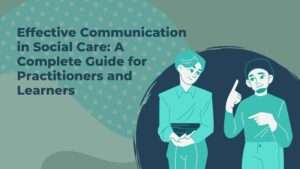Introduction
One of the most important abilities in the health and social care industry is effective communication. Learners at Level 3 go deeper into the fundamentals, forms, difficulties, and significance of communication in professional care settings. In order to fully comply with Google’s content criteria, this article offers a comprehensive, learner-friendly, and SEO-optimized approach to Communication in Health and Social Care Level 3.
This guide will help you comprehend the theories, laws, methods, and real-world applications that make communication essential in person-centered care, regardless of whether you are a trainee, a Level 3 diploma student, or a care professional seeking to further your understanding.
What Does ‘Communication in Health and Social Care Level 3’ Mean?
This term refers to the unit of study or module commonly found in Level 3 health and social care courses. It focuses on:
- Types of communication used in care settings
- Barriers to communication
- How to support effective communication
- Legal, ethical, and professional frameworks that govern communication
- Skills for communicating with service users, families, and multidisciplinary teams
It is a core component of Level 3 diplomas and apprenticeship qualifications in health and social care.
Why Is Communication Important in Health and Social Care?
Communication serves as the foundation for every care interaction. It helps:
- Understand service users’ needs, preferences, and emotions
- Build trust and professional relationships
- Coordinate care between professionals
- Promote inclusion, equality, and dignity
- Support informed decision-making
- Ensure safety and effective response to concerns
Poor communication can lead to misunderstandings, distress, care errors, or even safeguarding failures.
Theoretical Models of Communication (Level 3 Content)
1. Tuckman’s Stages of Group Communication
- Forming, Storming, Norming, Performing, and Adjourning
- Helps explain how teams communicate and evolve over time
2. Argyle’s Communication Cycle
- Six-stage model: Idea > Code > Send > Receive > Decode > Feedback
- Illustrates how successful communication is a two-way process
3. SOLER Model (Egan)
- Sit squarely, Open posture, Lean, Eye contact, Relax
- Encourages active listening and engagement
Types of Communication Used in Care Settings
1. Verbal Communication
- Conversations with service users
- Telephone and video calls
- Team meetings and handovers
2. Non-Verbal Communication
- Body language
- Facial expressions
- Eye contact
- Gestures
- Proximity
3. Written Communication
- Care plans and risk assessments
- Medical notes
- Emails and reports
4. Visual and Technological Communication
- Charts and pictograms
- Communication aids (e.g. talking mats)
- Assistive devices (e.g. text-to-speech software)
5. Specialist Communication Methods
- Makaton
- British Sign Language (BSL)
- Braille
- Objects of reference for individuals with complex needs
Principles of Effective Communication
- Person-centred approach
- Confidentiality and consent
- Cultural and religious sensitivity
- Clarity and simplicity
- Empathy and emotional intelligence
Barriers to Effective Communication
Environmental Barriers:
- Noise
- Poor lighting
- Lack of privacy
Personal Barriers:
- Sensory impairments (e.g. hearing loss)
- Language differences
- Mental health conditions
- Learning disabilities
- Emotional distress
Systemic Barriers:
- Time constraints
- Staff shortages
- Inefficient reporting systems
Strategies to Overcome Barriers:
- Use of interpreters
- Adapting the environment
- Employing assistive technology
- Active listening and patience
Communication and Legislation
Communication in health and social care is guided by several key laws and frameworks:
- Data Protection Act 2018 (GDPR) – Ensures confidentiality of information
- Human Rights Act 1998 – Right to expression and respect
- Equality Act 2010 – Prevents discrimination in communication
- Mental Capacity Act 2005 – Requires communication to support informed consent
- Care Act 2014 – Promotes dignity and person-centred approaches
Roles of Communication in Multidisciplinary Teams
- Share information securely and effectively
- Ensure continuity of care
- Support risk management and safeguarding
- Encourage collaboration and holistic planning
Communication in Specific Care Contexts
1. Elderly Care
- Use hearing aids, speak slowly
- Avoid jargon
- Offer written summaries
2. Mental Health
- Build trust over time
- Validate emotions
- Avoid intrusive body language
3. Childcare
- Use play-based communication
- Be clear and consistent
- Engage with family members
4. Disability Support
- Incorporate non-verbal methods
- Respect preferred communication aids
- Be patient and repetitive where necessary
Practical Activities to Develop Communication Skills
- Role plays
- Peer feedback sessions
- Observational practice in placements
- Creating communication passports
- Reflective journaling
Assessment Tasks in Level 3 Communication Unit
Typical assignments may include:
- Written reports or essays
- Case study evaluations
- Observed interactions in care settings
- Reflective accounts
- Oral presentations or group discussions
Skills Employers Look for (Linked to Communication)
- Professionalism and tact
- Accuracy in record-keeping
- Confidence in multidisciplinary meetings
- Ability to de-escalate conflict
- Non-judgmental attitude
- Willingness to learn and adapt
Tools and Resources
- SCIE (Social Care Institute for Excellence)
- NICE Communication Guidelines
- NHS Accessible Information Standard
- Communication training modules on FutureLearn and OpenLearn
- CPD certifications in effective communication
Career Paths That Benefit from Strong Communication Skills
- Care Coordinator
- Social Worker
- Mental Health Support Worker
- SEN Teaching Assistant
- Domiciliary Care Manager
- Family Liaison Officer
Conclusion
Communication in health and social care Level 3 is an essential life skill in addition to being an academic topic. Applying communication theories, navigating complicated demands, and interacting with ethical and legal frameworks are all demanded of learners at this level. By mastering this unit, potential care workers become not simply better communicators but more compassionate, effective, and professional carers.
Developing your communication skills is one of the best investments you can make, regardless of your objectives—passing your Level 3 diploma, becoming a better employee, or progressing in your care career. Because every word counts in care, keep learning, think back on your work, and maintain a person-centered approach.
Read More: Effective Communication in Social Care: A Complete Guide for Practitioners and Learners







